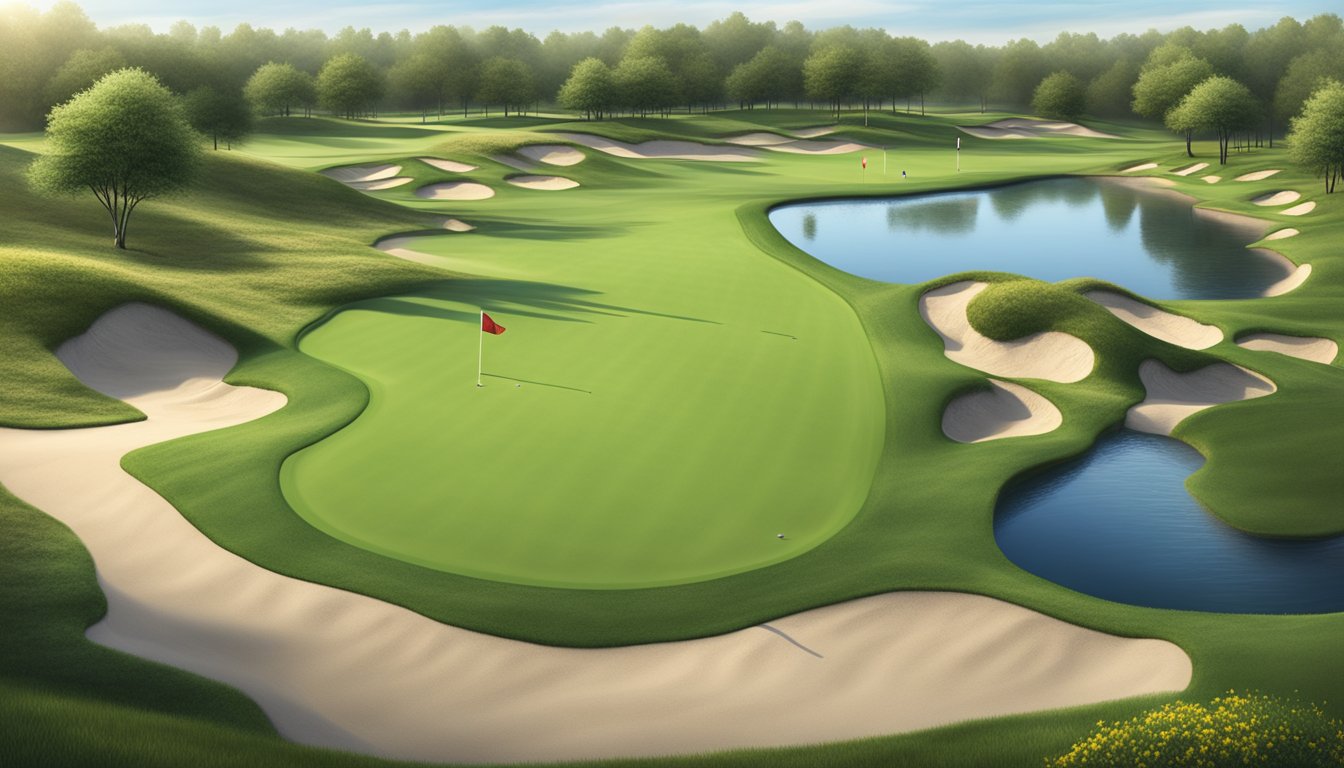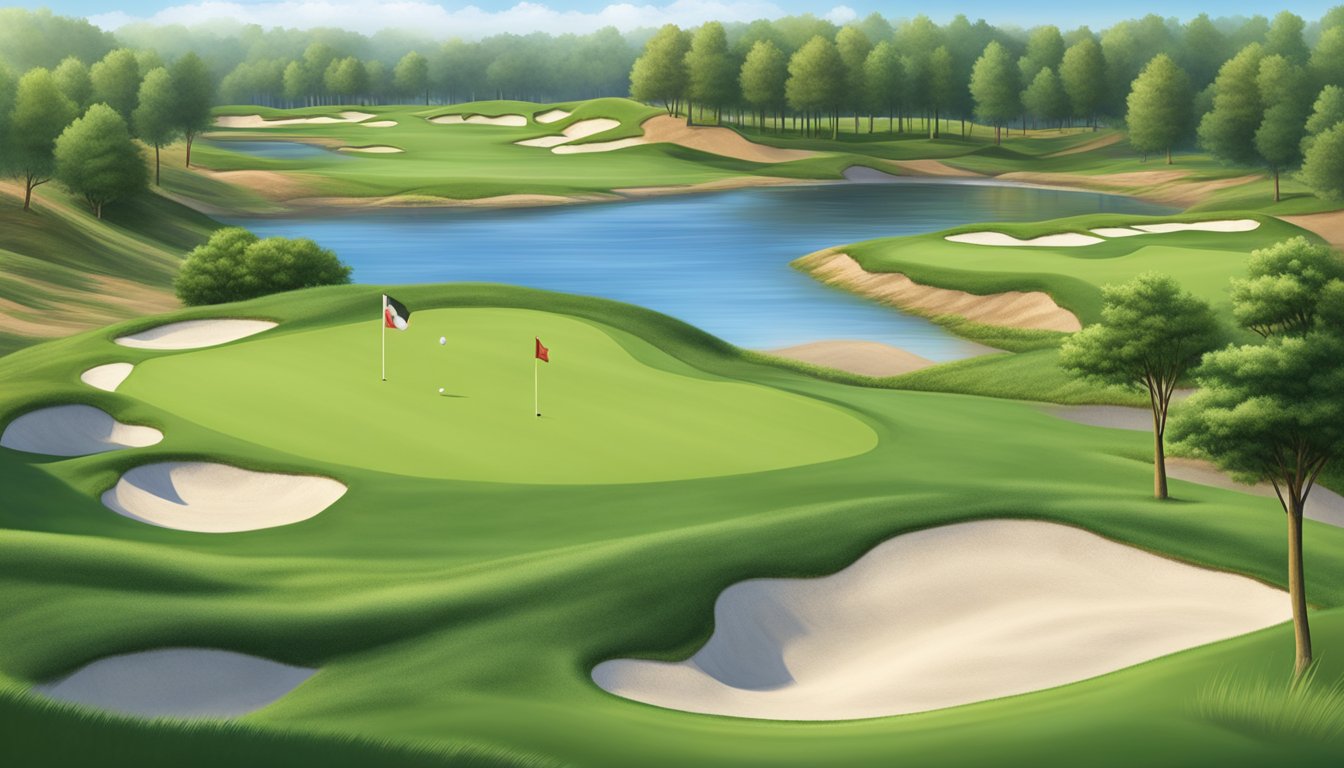If you’re new to the game of golf, it can be overwhelming to learn all the rules and terminology. However, understanding the fundamental rules of golf is essential to playing the game properly and enjoying it to the fullest. In this article, we will break down the basic rules of golf in a way that is easy to understand, so you can confidently hit the course and start playing.


First, we will discuss the importance of understanding the golf course and its layout. Knowing the different parts of the course, such as the fairway, green, and rough, will help you understand how to navigate the course and make strategic shots. We will also cover the basics of golf play, including how to properly hold and swing a golf club, as well as the different types of shots you can make.
Next, we will dive into the rules and etiquette of golf. From tee box etiquette to understanding the penalty for hitting a ball out of bounds, we will cover everything you need to know to play by the rules and be a courteous player. Additionally, we will provide tips for handling obstacles and hazards, such as bunkers and water hazards, and offer advice for beginners who are just starting out.
Key Takeaways
- Understanding the layout of the golf course is essential to playing the game properly.
- Proper golf etiquette is important for playing by the rules and being a courteous player.
- Knowing how to handle obstacles and hazards can help you improve your game.
Understanding the Golf Course

Playing golf involves understanding the layout of the golf course. A golf course typically consists of 18 holes, each with its unique set of challenges. Each hole has a tee box, fairway, bunkers, water hazards, and a green.
The tee box or teeing ground is where you start each hole. It is usually marked by two markers, and you must tee the ball up behind the line created by the markers. You can tee it up anywhere between the two markers, and you can tee it as far back as the length of two drivers. However, never tee the ball in front of the tee markers, or you will incur a penalty.
The fairway is the area between the tee box and the green. It is where you aim to hit your ball, and it is usually the easiest part of the hole. The fairway is often lined with trees, bunkers, or water hazards, making it challenging to hit the ball straight.
Bunkers are areas on the course filled with sand. They are strategically placed to make it difficult for golfers to hit their ball out of them. If your ball lands in a bunker, you must play it as it lies, and you are not allowed to touch the sand before making your shot.
Water hazards, also known as penalty areas, are bodies of water on the course. If your ball lands in a water hazard, you must take a penalty stroke and drop your ball outside the hazard.
The green is the area where the hole is located. It is usually a well-manicured area of grass, and it is where you aim to land your ball to complete the hole. The green is usually surrounded by rough, which is longer grass that makes it challenging to putt the ball.
In summary, understanding the layout of the golf course is crucial to playing a good game of golf. Knowing the location of the tee box, fairway, bunkers, water hazards, and green will help you plan your shots and navigate the course.
The Basics of Golf Play
https://www.youtube.com/watch?v=CN3ThL8DgFM&embed=true
Golf is a sport that requires precision, skill, and patience. Whether you’re a seasoned pro or a beginner, understanding the basics of golf play is crucial to enjoying the game and improving your skills.
Equipment
To play golf, you’ll need a few essential pieces of equipment, including golf clubs, golf balls, and a golf bag. Golf clubs come in different shapes and sizes, each designed for a specific purpose. You’ll need a driver for teeing off, irons for hitting the ball from the fairway, and a putter for putting on the green.
When selecting golf balls, choose ones that suit your skill level and swing speed. For beginners, it’s recommended to use low compression balls that offer more forgiveness on mishits.
Teeing Off
To start a hole, you’ll need to tee off. This involves placing the ball on a tee and hitting it with your driver. When teeing off, make sure to tee up behind the imaginary horizontal line created by the two tee markers. You can go as close to the markers as you like and tee up as far back as 90 inches.
Playing the Ball
One of the essential principles of golf is to play the ball as it lies. This means you shouldn’t move, touch, or alter the ball’s position unless the rules allow it. You have to attempt to make a stroke AT THE BALL for it to count as a shot.
When hitting the ball, focus on keeping your head down and your eye on the ball. Make sure to swing through the ball and follow through with your swing.
Putting
Putting is a crucial part of the game and requires a delicate touch. The putting green is the area around the hole where you’ll need to get the ball in as few strokes as possible. Make sure to read the green and take into account the slope and speed of the putting surface.

Scoring
In golf, the objective is to score the lowest number of strokes possible. In stroke play, you count all your shots for each hole, and the player with the lowest score at the end of the round wins. In match play, you compete against another player, and the winner is determined by who wins the most holes.
Whether you’re playing in a competition or for casual play, understanding the basics of golf play is essential to enjoying the game and improving your skills.
Rules and Etiquette
https://www.youtube.com/watch?v=99nN7WWNF1Q&embed=true
Golf is a game that requires both skill and etiquette. Following the rules of golf and practicing proper etiquette is essential to ensure that everyone enjoys the game. The rules of golf are set by the USGA and are designed to maintain the integrity and fairness of the game.
When playing golf, it’s important to know the basic rules of golf. These rules include the order of play, player conduct, and penalties. The order of play is determined by the score of the previous hole. The player with the lowest score on the previous hole has the honor of teeing off first on the next hole.

Proper player conduct is also important in golf. Players should not talk or make noise while other players are hitting their shots. Players should also not walk on or through another player’s putting line. If a player breaches these rules, they may be penalized with a penalty stroke or even disqualified from the game.
There are also specific rules for situations such as unplayable lies, out of bounds, and lost balls. These rules are designed to ensure that players can continue playing the game fairly and without penalty. For example, if a player hits a ball out of bounds, they must take a penalty stroke and replay the shot from the original location.
In addition to the basic rules of golf, there are also specific etiquette rules that should be followed. These include raking bunkers after hitting out of them, repairing divots on the fairway, and not stepping on the putting green. These rules are not only polite but also help to maintain the course for future players.
It’s also important to note that local rules may apply at different golf courses. These rules are usually posted in the clubhouse or on the scorecard and should be followed accordingly.
By following the rules of golf and practicing proper etiquette, you can ensure that everyone enjoys the game. Remember to always be respectful of other players and the course, and you’ll be on your way to becoming a great golfer.

Handling Obstacles and Hazards
https://www.youtube.com/watch?v=gfjY8G79MEI&embed=true
Golf is a game that requires you to navigate around obstacles and hazards to reach your target. Obstacles can be trees, bushes, or any other object that interferes with your shot. Hazards, on the other hand, are areas of the course that are designed to be challenging and can result in a penalty if your ball lands in them.
Water Hazards and Penalty Areas
Water hazards and penalty areas are two types of hazards that you need to be aware of when playing golf. A water hazard is any body of water on the course, such as a lake or a pond. If your ball lands in a water hazard, you have to take a penalty stroke and drop your ball behind the hazard. On the other hand, a penalty area is any area on the course that is designated as a penalty area. If your ball lands in a penalty area, you have to take a penalty stroke and drop your ball within two club lengths of where it entered the penalty area.
Bunkers
Bunkers are another type of hazard that you will encounter on the course. Bunkers are areas of the course that are filled with sand and are designed to be challenging to play from. If your ball lands in a bunker, you have to play it as it lies. You are not allowed to touch the sand with your club before you make your shot. You can, however, rake the sand after you have made your shot to leave the bunker in good condition for the next player.
Unplayable Lies and Dropping
If your ball lands in an unplayable lie, you have a few options. You can take a one-stroke penalty and drop your ball within two club lengths of where it was, no closer to the hole. You can also take a one-stroke penalty and drop your ball as far back as you want on a line between the hole and where your ball was. Finally, you can take a one-stroke penalty and replay your shot from where you originally played it.
Impediments
Impediments are any objects on the course that interfere with your shot, such as a tree branch or a rock. If your ball is in a position where an impediment interferes with your shot, you are allowed to move the impediment if it is not fixed or growing. If the impediment is fixed or growing, you are not allowed to move it and must play your shot as it lies.
Remember, the goal of golf is to get your ball into the hole in as few strokes as possible. By understanding how to handle obstacles and hazards, you can improve your game and have more fun on the course.
Tips for Beginners
https://www.youtube.com/watch?v=G9j4BrCT5oU&embed=true
If you’re new to golf, it can be overwhelming to learn all the rules and techniques. Here are some tips to help you get started:
Practice Swings
Before you hit the ball, take a few practice swings to warm up and get a feel for your swing. This is especially important for beginners who may need to work on their technique. Be sure to take your practice swings away from the ball to avoid accidentally hitting it.

Markers and Divots
When playing on the course, it’s important to mark your ball’s position on the green with a marker. This will help you avoid accidentally moving your ball when you’re lining up your shot. Additionally, be sure to replace any divots you make on the course to help maintain the course’s condition.
Handicap and Skill Level
As a beginner, you may not have a handicap yet. A handicap is a measure of a player’s skill level, and it’s used to level the playing field when playing against more experienced players. As you improve your game, you can work on lowering your handicap.
Course Guidelines and Player Conduct
Be sure to follow the course guidelines and rules of player conduct when playing on the course. This includes being mindful of other players on the course, repairing any damage you cause, and following the pace of play.
Ball Search
If you hit your ball off the course, you’ll need to search for it. Be sure to follow the rules for ball search, which include a time limit for finding the ball and taking a penalty stroke if you can’t find it.
Overall, golf is a challenging but rewarding sport that requires practice and patience. With these tips in mind, you can manage your game and improve your skills over time.

Frequently Asked Questions
https://www.youtube.com/watch?v=OFyX4IFQoLQ&embed=true
What are the basic rules of golf?
The basic rules of golf include playing the ball as it lies, counting all strokes, and playing the course as it is. You are not allowed to move, touch, or alter the position of the ball unless the rules allow it. You must also count all strokes, including penalties, and play the course as it is without making any changes to it.
What happens if you hit your tee shot in the water?
If you hit your tee shot in the water, you must take a penalty stroke and replay your shot from the original position. This is called a “stroke and distance” penalty. You can also take a drop from a designated drop zone, if available, but this will also result in a penalty stroke.
What happens if you take a drop and then find your ball?
If you take a drop and then find your ball, you must pick up the dropped ball and continue playing the original ball from where it was found. If you play the dropped ball, you will be assessed a penalty stroke.
What are the rules for hazards and out of bounds in golf?
Hazards and out of bounds are areas on the course that are designated by the course designer as being difficult or dangerous to play. If your ball lands in a hazard, you may take a drop outside of the hazard with a penalty stroke. If your ball goes out of bounds, you must take a penalty stroke and replay your shot from the original position.

What are some common golf rules questions?
Common golf rules questions include how to handle lost balls, how to handle unplayable lies, and what to do if your ball hits another player or their equipment. It is important to understand the rules of golf to avoid penalties and play the game fairly.
What resources are available to learn the rules of golf?
There are many resources available to learn the rules of golf, including rule books, online courses, and instructional videos. The United States Golf Association (USGA) provides a comprehensive set of rules and resources for players of all levels.










